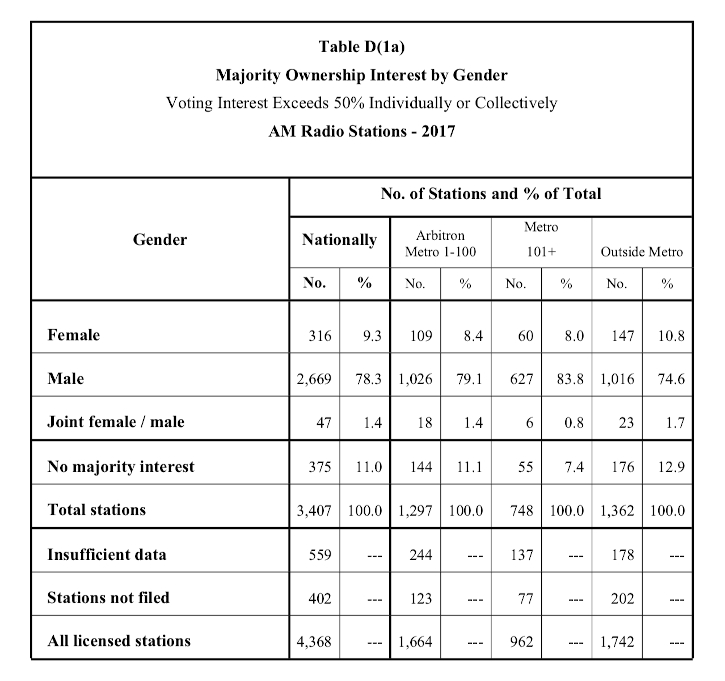The Federal Communications Commission released its most recent report on the ownership of broadcast stations across the U.S. For the first time it also gathered data on the gender, ethnicity and race of those with an attributable interest in noncom educational stations.
The results revealed that women and minorities still hold only a small fraction of majority ownership in U.S. broadcast stations.
[Read: America’s Broadcasters Should Look Like America]
For example, the report revealed that women collectively or individually held a majority interest in 874 commercial broadcast stations, compared to their male colleagues who hold a majority interest in 8,736.
Yet the report also reveals that radio is an industry providing a higher percentage of attributable ownership opportunities for women and minority groups. According to the report, based on information submitted by licensees in response to the FCC 2017 biennial ownership report, women hold a greater percentage of majority voting interest in commercial AM radio (8.9%) when compared to full-power commercial television (5.3%).
The same trends were seen when in tracking ethnic groups across radio. Hispanic and Latino individuals held a held a discernable majority voting interest in 4.2% of all full-power commercial television stations as compared to 6.1% of commercial AM stations.
Radio World will shortly publish second item with more data about radio specifically.
The disparity was similar when comparing the race of commercial station owners. Those who identify as white were reported to hold a majority interest in 10,076 commercial broadcast stations compared with 416 commercial stations owned by those who identify as a racial minority.
Ownership based on racial group was broken down further:
- Black/African Americans owned 239 commercial broadcast stations;
- Asians owned 136 commercial broadcast stations;
- American Indian/Alaska Natives owned 31 commercial broadcast stations;
- Native Hawaiian and other Pacific Islanders owned seven commercial broadcast stations.
The numbers played out similarly when it came to noncommercial broadcast stations.
Women collectively or individually hold a voting interest in 401 noncommercial broadcast stations. While women have a 9% stake in noncommercial FM radio stations (a total of 314 across the country), not one woman was listed as holding a majority in any noncommercial Class A television stations. Compare that to the noncommercial ownership numbers for men, which collectively or individually hold a majority of the voting interests in 2,564 noncommercial broadcast stations, including 2,086 FM radio stations.

Racial minorities holding a majority of the voting interest at noncommercial stations includes 109 noncommercial broadcast stations, including 12 AM radio stations and 91 FM radio stations.
Ethnicity was also tracked as part of the report. Those who do not identify as Hispanic or Latino hold voting interests in 9,836 commercial broadcast stations, compared to only 668 Hispanic/Latino owners. For noncommercial stations, the numbers were still stark: Non-Hispanic/Latino persons collectively or individually held a majority interest in 3,100 noncommercial broadcast stations, compared to 121 noncommercial broadcast stations.
“It is striking — but not surprising — that no minority group is better off in owning more full-power commercial broadcast stations than they did in 2015,” said FCC Commissioner Geoffrey Starks in a statement. The year 2015 was the last year that this type of ownership data was collected. Of 1,385 stations, African-Americans owned just 12 stations in 2015 — “an anemic figure to be sure,” he said — and still owned just 12 stations in 2017.
Many minority groups saw their ownership numbers worsen, he said, including American Indian or Alaska Native women. “They lost all eight stations in which they held a majority ownership interest in 2015,” Starks said, which was the last year that the report was produced.
Women lost ground overall, representing only 5.3% of full-power commercial station owners, down from 7.4% in 2015.
“I have said it before: America’s broadcasters must look like America,” said Starks, one of two Democrats currently sitting on the five-member FCC. “We have much work to do — and it starts with us fulfilling our direct order from the Third Circuit to implement a data program that would help understand the impact of our regulatory efforts on the ability of women and people of color to own stations.”
In addition to a breakdown on gender, ethnicity and race, the report includes a comparison of 2017 and 2015 data for full-power commercial television, Class A television, low-power television, commercial AM radio, and commercial FM radio stations; as well as detailed ownership information in a series of tables and spreadsheets.
Reports can be searched via licensee name, call sign, service or FCC Registration Number here.












